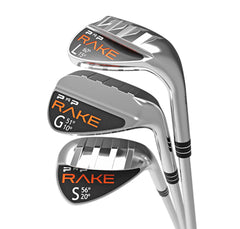February 01, 2019
Wrapping your head around the differences between golf wedges can be difficult, especially if you’re new to the game. What is each golf wedge used for, and at what point do you know which wedge to reach for?
Depending on the shot you're going for, using the wrong wedge can have horrendous consequences, besides negatively affecting your score, it can also make you look like you don't quite know what you're doing. Golf can be stressful on a good day, leading one to wish you could just throw your clubs away, give up the whole golf thing and go camping. That's why having a solid understanding of the different wedges is so important. It can mean the difference between a healthy score, or frustration and embarrassment.
The primary differentiating factor between wedges is the degree of loft each wedge club has. The trajectory of the ball when correctly struck is determined by the loft of the golf club. The higher the degree of loft, the faster the golf ball travels into the air.
The pitching wedge is the default wedge included in virtually every set of golf clubs. This wedge has a loft of between 44 and 49 degrees and is designed to be able to get under the golf ball on contact.
They’re ideally used to hit shots from distances of between 100 and 115 meters (110 and 125 yards). When being used the player is usually looking to get the ball high into the air and have it head toward the putting green, landing it as near to the hole as possible.
Having an accurate understanding of how far one can hit the ball with the pitching wedge is important as this will enable the golfer to know when to use this wedge as opposed to the others below.
The gap wedge basically fills the gap (mind the pun!) between the pitching wedge and the sand wedge. It falls in between the two due to its loft of between 50 and 54 degrees.
This club is used to hit the ball between 80 and 100 meters (90 and 110 yards). This means that, rather than having to use a pitching wedge softly, or using a sand wedge with extra force, one can opt for the gap wedge, which can accomplish the task with a relaxed and full swing.
When it comes to having the full set of wedges, the rule of thumb is that between each wedge there should be a four degree difference in loft. A golfer with a pitching wedge of 46 degrees, should have a gap wedge of 50, a sand wedge of 54 and a lob wedge of no less than 58 degrees.
The RAKE Gap Wedge is at the fore with a 51 degree loft and 10 degree rail entry bounch combined with the 6 degrees of sole bounce. This makes it an incredibly versatile gap wedge and sets it apart from the rest.
The Sand Wedge was the first wedge to be designed almost solely to help the player out of the sand. It was first made in 1930, and since then has grown in popularity, with it now being used to hit the ball from not just sand, but also high grass and the fairway.
Sand wedges traditionally come with lofts between 54 and 58 degrees, along with a slightly heavier than normal head weight. When is the sand wedge used? A golfer will select the sand wedge when he/she needs to cover a distance of between 70 and 90 meters (80 - 100 yards), and needs to get the ball into the air quickly.
Usually, and when played correctly, the ball will come to a quick stop on the green when it lands due to the height that the ball reaches.
Occasionally a sand wedge will be included with a set of golf clubs, other times it must be purchased separately.
The rails on the RAKE Sand Wedge make it a top contender with a 56 degree loft and 20 degree rail entry bounce combined with the 10 degrees of sole bounce. Due to the rail feature, the head is able to move through sand more easily, awhile allowing the player to maintain control.
With a loft of between 59 and 65 degrees, and a thinner leading edge, the lob wedge will be the best choice when the golfer is needing to clear a particularly high rough.
Your experienced player will hit the ball cleanly to send the it high into the air, and have it land on the green with a good deal of spin.
Due to the higher degree of loft, a player can take a full swing and still only hit a lob wedge between 55 and 65 meters (60 and 70 yards), having the ball rise rapidly and come down on the putting surface.
This wedge must be bought separately as it’s not included in any club sets.
The PNP RAKE Wedges stand out from the traditional Sand, Gap and Lob  wedges due to a number of important factors.
wedges due to a number of important factors.
Their patented Rail design, undercut cavity, zero heel bounce, and their advanced on-set leading edge, all contribute toward giving the golfer an advantage out on the course.
The single blunt bounce found in traditional wedges has now been broken up into two bounces, i.e. the rail bounce, and a secondary ‘between rail’ sole bounce.
The rail bounce design allows the club to comb through the grass and sand, resulting in more acceleration and less effort. The patented design of the RAKE club head has a gap between the two bounces that provides an avenue for the sand, turf and other hazards to pass through. Besides the additional acceleration and lowered friction, this feature also helps to further stabilise the club head.
Please click here for further information on the PNP RAKE wedges.
January 24, 2020
December 22, 2017
December 21, 2017
